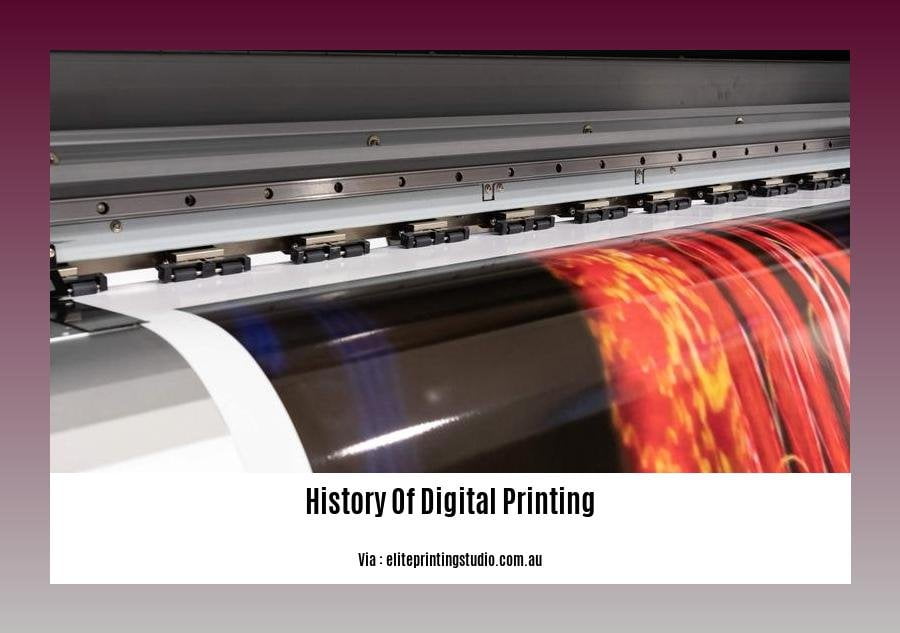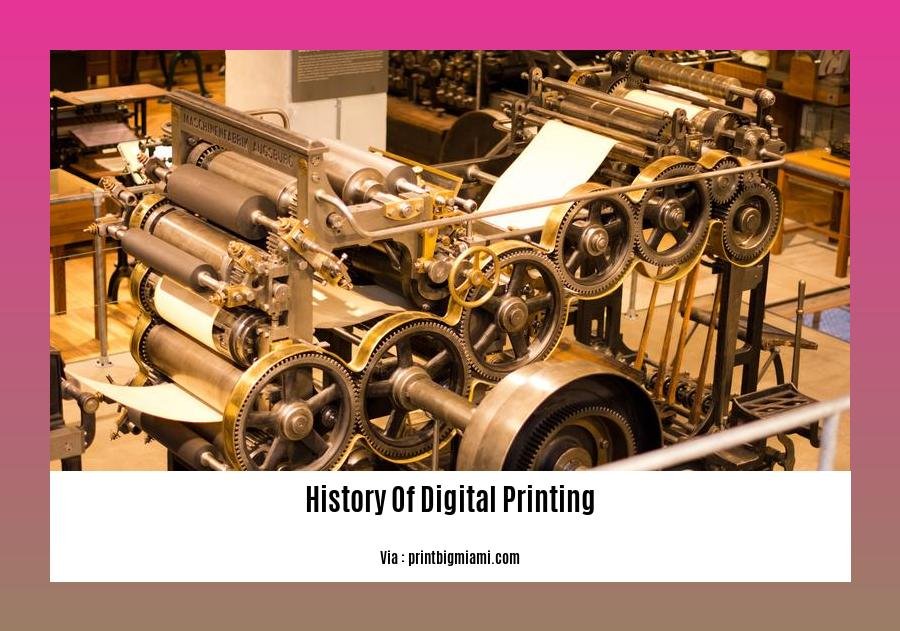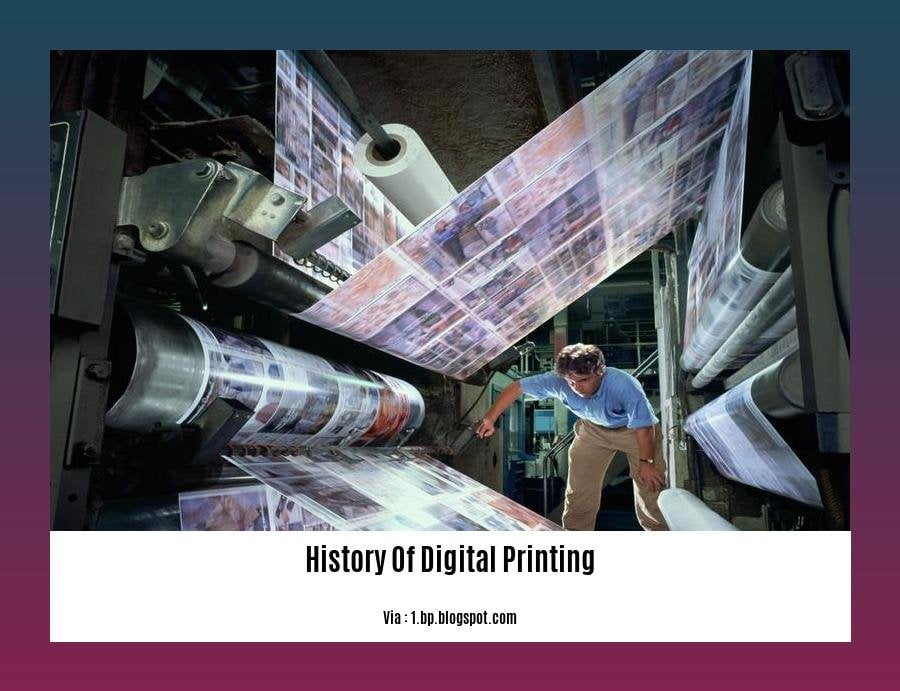From the era of traditional printing methods to the cutting-edge realm of digital technology, the journey of digital printing has revolutionized the way we create and reproduce images and text. Join us on an exploration of this transformative technology, as we delve into its humble beginnings, trace its remarkable evolution, and uncover how it has reshaped industries and redefined artistic expression. In this article titled [A Journey Through Innovation: Exploring the History of Digital Printing], we will embark on a captivating narrative that unveils the remarkable story behind the digital printing revolution.
Key Takeaways:
The inception of digital printing dates back to 1991.
Unlike traditional printing methods, digital printing employs digital data to generate printed images.
The first printed material consisted primarily of Bibles, crafted using rudimentary techniques.
Johannes Gutenberg revolutionized printing in the 15th century by introducing a mechanical printing process that utilized movable type.
The surge in popularity of digital printing can be attributed to the introduction of affordable and user-friendly digital cameras.
**The History of Digital Printing: A Revolutionary Transformation**

Digital printing has revolutionized the way we create and reproduce images and text. It’s a technology that’s taken the world by storm, transforming industries and opening up new possibilities for communication and expression.
The Early Days of Printing
The history of digital printing can be traced back to the early days of printing itself. In the 15th century, Johannes Gutenberg invented the printing press, which used movable type to transfer ink onto paper. This invention marked a major turning point in the history of communication, making it possible to mass-produce books and other printed materials.
The Rise of Digital Technology
In the 20th century, the development of digital technology led to a new era of printing. In 1991, the first digital printing press was invented, and it quickly gained popularity due to its ability to produce high-quality images and text at a low cost.
The Digital Revolution
The advent of digital printing sparked a revolution in the printing industry. It made it possible to print on a wide variety of materials, including paper, plastic, and metal. It also allowed for the creation of variable data printing, which enabled businesses to personalize their marketing materials.
The Future of Digital Printing
Digital printing is still in its early stages of development, and it’s expected to continue to evolve and improve in the years to come. There are several trends that are shaping the future of digital printing, including:
- The increasing use of inkjet technology
- The development of new materials and inks
- The integration of digital printing with other technologies, such as 3D printing
These trends are likely to make digital printing even more versatile and accessible, opening up new possibilities for businesses and consumers alike.
Do you know when was the first disc golf tournament was held? Explore the history of disc golf to find out more about its fascinating origins and evolution.
If you’re passionate about fashion, immerse yourself in the history of dressmaking, tracing its journey from humble beginnings to haute couture.
Discover the events and milestones that shaped the development of emergency medical services in the comprehensive history of EMS timeline.
Delve into the rich legacy of English drama as we journey through the history of English drama in the 11th class, exploring the works of renowned playwrights and the cultural context of the era.
History of Digital Printing Technology

From humble beginnings to a revolutionary force, the history of digital printing technology is a captivating journey of innovation and transformation.
The Genesis of Digital Printing
The seeds of digital printing were sown in the early days of computing, when visionary researchers pondered the possibilities of printing directly from digital images. These early pioneers laid the groundwork for a technology that would redefine the printing landscape.
The 1970s: Dawn of Commercial Digital Printing
In the 1970s, the first commercial digital printers emerged, heralding a new era in printing technology. These early machines, though limited in speed and resolution, paved the way for the digital revolution that was to come.
The 1990s: Digital Printing Goes Mainstream
The 1990s witnessed the mainstream adoption of digital printing technology, as advancements in computing power and affordability made digital printers accessible to a wider range of businesses and consumers. This period marked a turning point in the history of digital printing.
Advantages of Digital Printing
Digital printing offers several advantages over traditional printing methods, including faster turnaround times, variable data printing capabilities, and the ability to print on a wide range of media. These advantages have made digital printing the preferred choice for many applications, including commercial printing, direct mail, and packaging.
Conclusion
The history of digital printing technology is a testament to the power of innovation and the relentless pursuit of progress. From its humble origins to its current status as a mainstream technology, digital printing has revolutionized the way we print and communicate.
Key Takeaways:
- Digital printing emerged as a transformative technology in the early days of computing.
- The first commercial digital printers were developed in the 1970s, paving the way for mainstream adoption.
- The 1990s marked a turning point, as digital printing became more accessible and affordable for businesses and consumers.
- Digital printing offers advantages such as faster turnaround times, variable data printing, and the ability to print on various media.
- Today, digital printing is widely used in commercial printing, direct mail, packaging, and various other applications.
Sources:
Digital Printing: A Brief History
Advantages of Digital Printing
History of Digital Printing Timeline
Throughout history, the printing press has undergone a remarkable transformation, revolutionizing the way we share information. From the early days of movable type to the advent of digital technology, let’s embark on a journey through innovation to explore the fascinating History of Digital Printing Timeline.
Key Takeaways:
- Digital printing emerged in the early 1900s but gained prominence in the 1990s due to technological advancements.
- Compared to traditional methods, digital printing offers superior image quality, faster turnaround times, and cost-effectiveness for short runs.
- Digital printing finds diverse applications in commercial printing, photo printing, and industrial printing.
- The future of digital printing promises continued innovation, such as 3D printing, personalized printing, and eco-friendly technologies.
Early Experimentation and Innovation
The seeds of digital printing were sown in the early 1900s when visionary researchers explored the possibility of printing directly from digital images. The invention of computers and digital cameras laid the foundation for digital printing’s eventual commercialization.
The Rise of Commercial Digital Printing
The 1970s marked a significant milestone with the introduction of commercial digital printers. These machines opened up new possibilities for printing, offering higher resolution and more precise color reproduction. The 1990s witnessed the mainstream adoption of digital printing technology, driven by advancements in computing power and affordability.
Advantages of Digital Printing
Digital printing offers several advantages over traditional printing methods:
- Image Quality: Digital printing produces higher quality images with sharper details and vibrant colors.
- Turnaround Time: Digital printing significantly reduces turnaround times as it eliminates the need for plate making and setup.
- Cost-Effectiveness: Digital printing is more cost-effective for short print runs compared to traditional methods.
- Variable Data Printing: Digital printing allows for variable data printing, enabling the customization of each printed piece with unique information.
- Media Versatility: Digital printing can print on a wide range of substrates, including paper, cardstock, plastic, and fabric.
Embracing Digital Printing’s Future
Digital printing continues to evolve, with ongoing innovations shaping its future:
- 3D Printing: 3D printing, a revolutionary technology, enables the creation of three-dimensional objects directly from digital files.
- Personalized Printing: Personalized printing allows for the creation of customized products with unique designs or messages.
- Eco-Friendly Technologies: Digital printing technologies are becoming more environmentally friendly, using less energy and producing less waste.
Conclusion
Digital printing has revolutionized the printing industry, transforming the way we print and disseminate information. Its journey from early experimentation to widespread adoption is a testament to innovation and technological advancements. As we look towards the future, digital printing continues to push boundaries, promising even more exciting possibilities for the printing landscape.
References:
- Digital Printing: A Brief History
- The History of Digital Printing
FAQ
Q1: When did digital printing emerge as a mainstream technology?
A1: Digital printing came to the forefront as a dominant printing technology in the 1990s after decades of research and development since the early days of computing.
Q2: What are the primary advantages of digital printing?
A2: Digital printing offers a multitude of advantages over traditional methods, including faster turnaround times, variable data printing, personalized printing, and on-demand printing capabilities.
Q3: How has the popularity of digital printing evolved?
A3: Initially introduced in the 1970s, digital printing gained widespread acceptance in the printing industry during the 1990s due to advancements in computer and digital camera technologies.
Q4: What is the current status of digital printing in the printing industry?
A4: Digital printing stands as the fastest-growing printing process, employed in a diverse range of industries, such as commercial printing, photo printing, and industrial printing.
Q5: What are some examples of different digital printing techniques?
A5: Common digital printing techniques include inkjet, laser, and solid ink printing, each offering unique advantages and applications.
- What is a Bunch of Deer Called? A Complete Guide to Deer Group Names - April 16, 2025
- Is a Bird an Animal?Science Explains Avian Classification - April 16, 2025
- The Peasant St John Gastropub: London’s Hidden Gem - April 16, 2025
















